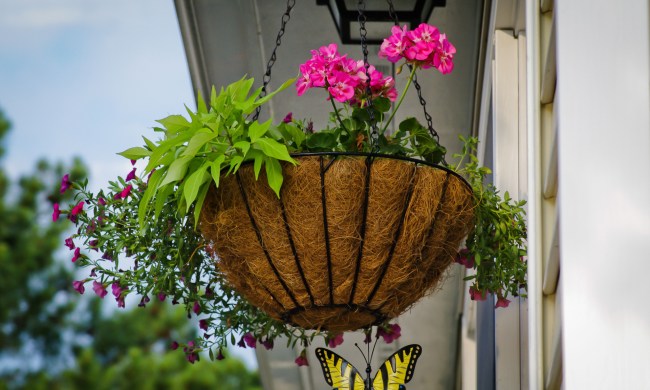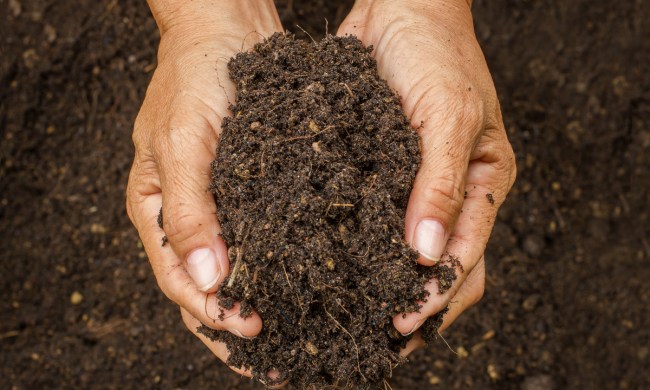Ferns are beautiful, unique garden plants that often grow well in shadier locations. For gardeners with a lot of trees, these are go-to options for ground coverage, filling in spaces, and just generally sprucing up the area. Because ferns are grown primarily for their foliage, many gardeners will pick and choose between the different varieties based on the look and colors they want for their garden beds. Below are some of our favorite unique and popular varieties
Himalayan maidenhair fern
Scientifically known as the Adiantum venustum, the Himalayan maidenhair fern is a perennial that grows in USDA hardiness zones 5 through 8. This variety is often described as delicate, known for its lace-like foliage and quick-spreading nature. These plants grow a foot tall (at most) and have a creeping nature that makes them perfect for ground coverage in shadier garden beds or under tree canopies. They also make beautiful container plants if you have a patio or other outdoor space looking for a natural presence.
Helpful care tips for this variety
The Adiantum venustum is relatively pest-free, but can occasionally encounter problems with scale insects. Proper care and tending to the fern will help keep it as healthy as possible to ward off insects and disease; however, if you notice a problem, you should tend to it immediately to avoid any potential spreading.
Light needs: Partial shade
Water needs: Enjoys environments with medium moisture
Soil needs: Well-draining soil

Hart’s tongue fern
The Hart’s tongue fern (Asplenium scolopendrium) is an evergreen, perennial fern that grows up to 32 inches in height. Unfortunately, much of their natural growing zones have been destroyed due to human expansion, making this plant hard to get ahold of. Some nurseries specialize in the cultivation of this fern variety, and if you’re lucky enough to get your hands on one, they make a beautiful plant for an outdoor garden bed. Plus, you could help reintroduce them to the environment and keep them from becoming fully eradicated.
Helpful care tips for this variety
Because this cultivar is highly sensitive to natural influences, its best chance of thriving is when it’s planted in a sheltered location. This could be under some trees or in a garden bed that has some protection. Because their natural habitat is primarily rocky regions, you can even plant them around some rocks in your garden where they’ll fit right in.
Light needs: Partial sun to full shade
Water needs: Water regularly during the first season, then only when conditions are dry
Soil needs: Well-draining soil
Japanese painted fern
If you’re looking for a fern with a bit more visual interest, the Japanese painted fern (Athyrium niponicum) is a beautiful choice. The foliage is silver-gray, turning purple as you get closer to the center, and grows from purple-red stems. The Japanese painted fern is another low-growing variety that can thrive in USDA hardiness zones 3 through 8 and is perfect for filling in blank spots in your shady garden beds.
Helpful care tips for this variety
Although this variety can thrive in full shade, you’ll get the most vibrancy out of the unique coloring when a little sun is introduced to the environment. If you’re planting the Japanese painted fern with the intent to diverge from the green foliage, you’ll want to prioritize partial shade locations where some sun is present during the day.
Light needs: Partial to full shade
Water needs: Regular watering; enjoys moist (not soggy) conditions
Soil needs: Well-draining, moist soil
Wallich’s wood fern
Known scientifically as the Dryopteris wallichiana, the Wallich’s wood fern is a deciduous fern cultivar that’s native to Hawaii, Jamaica, and Mexico. Unlike the other ferns we’ve talked about, this variety can get up to four feet in height in the right conditions — making it more of an accent plant than simple ground coverage.
Helpful care tips for this variety
The Wallich’s wood fern is a relatively low-maintenance variety. It doesn’t mind heavy shade environments, so if you have a garden bed that gets much less light than all the others due to trees or shade from a house or fence, this plant is a perfect addition. It’s important to note, though, that the fronds will collapse during the winter. Around late February or early March, you should remove the spent fronds, cutting the plant back to the ground, to make room for new, healthy growth.
Light needs: Partial to full shade
Water needs: Water to maintain moist conditions but avoid sogginess
Soil needs: Moist, well-draining soil

The ostrich fern
The ostrich fern (Matteuccia struthiopteris) can grow well in USDA hardiness zones 3 through 7 and is native to eastern Asia, eastern North America, and Europe. Ostrich ferns can grow anywhere from three to six feet in height, spreading up to eight feet, if given the room. You may find yourself needing to tend to this plant to avoid it taking over; however, if you’re just looking for some ground cover under trees in your backyard, the ostrich fern is perfect.
Helpful care tips for this variety
Ostrich ferns don’t have any particular weakness to disease or pest problems, which makes them a wonderful choice for undergrowth and shady garden beds. If conditions get too soggy, though, they will start to rot and die like other plants. They like a bit of moisture, but too much can cause the roots to drown.
Light needs: Partial to full shade
Water needs: Regular waterings for medium moisture
Soil needs: Well-draining
The basket fern
Also commonly referred to as the shield fern or the male fern, the Dryopteris filix mas is a cultivar that’s native to most northern temperate regions. It grows well in USDA hardiness zones 4 through 8 and is a relatively low-maintenance variety you can add to your garden.
Helpful care tips for this variety
The basket fern, although low maintenance, is a very delicate variety and needs to be planted in a location that’s protected from high winds and extreme weather damage. The ideal location for them would be a shadier garden bed along the side of a house, garage, or fence that can provide some shelter and help keep the fronds from getting damaged.
Light needs: Partial to full shade
Water needs: Regular waterings for medium moisture
Soil needs: Well-draining soil; take care to keep it from drying out
The royal fern
A fern of many aliases (ditch fern, kidney fern, and rusty fern, to name a few others), the Osmunda regalis is a gorgeous variety that grows well in USDA hardiness zones 3 through 9. This fern can get anywhere from two to three feet tall in the right conditions, spreading to an equal amount of distance. The royal fern is deciduous, growing natively along moist ledges and the edges of streams.
Helpful care tips for this variety
The best way you can tend to this cultivar is by keeping its native habitat in mind. Sometimes it can feel like you’re easily providing too much water, but when you consider that it loves to grow alongside small water beds and in generally moist environments, you’ll have an easier time. Do your best to keep the soil from drying out.
Light needs: Partial shade
Water needs: Regular watering for medium moisture
Soil needs: Moist, well-draining soil
Ferns are delicate, beautiful greenery that can enhance almost any garden bed or undergrowth area. These varieties are just the tip of the iceberg — there are so many out there that you can grow, not only in an outdoor garden but in greenhouses, containers, and indoors as well. Be mindful of their care, and you’ll see them thriving in no time.


